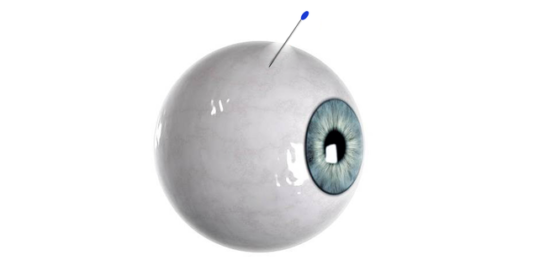Needle in the eye, transplanting an immune system, CDC’s odd sex advice, and more
21 Jun 2022
Posted by Andrew Kantor
And don’t forget the ice cream
When a kid gets a tonsillectomy, there’s a simple way to reduce their pain (and narcotic use): celecoxib, aka Celebrex. It’s an NSAID, of course, but it only works so-so for adults. For kids, though, researchers at Children’s Hospital of Philadelphia found that jacking up the dose and combining it with acetaminophen cuts down the need for opioids, big time.
The higher dose is the trick — it works because kids clear drugs out of their systems much faster. The result of their study was a 36% drop in oxycodone consumption and no adverse effects. And for the kids in prolonged pain, it cut opioids down even more.
They were so happy with the result that celecoxib after tonsillectomy is now routine procedure at the hospital.
Transplants without drugs
Let’s say a kid needs a kidney transplant. How can you do that without putting him on immunosuppressants for the rest of his life?
Duh! You transplant the immune system, too. That’s what physicians at Stanford have done in a process called “Hematopoietic Chimerism.” Or, to avoid big science words, a “dual immune/solid organ transplant.”
The Stanford innovation removes the possibility that the recipient will experience immune rejection of their transplanted organ. […] The new procedure also rids recipients of the substantial side effects of a lifetime of immune-suppressing medications, including increased risks for cancer, diabetes, infections and high blood pressure.
The big breakthrough was devising the procedure that makes the bone-marrow (i.e., immune system) donation safe — a process called “alpha-beta T cell depletion.” The new immune system is able to take hold within 60 to 90 days, after which the new kidney can be plugged in.
We don’t have to take our clothes off
Ever being proactive, the CDC has issued a helpful PDF guide to having sex with someone who may have monkeypox; it includes this tidbit: “Consider having sex with your clothes on or covering areas where rash or sores are present.” Um.
Forbes’s Bruce Lee (no relation) reports.
How exercise fights cancer
Exercise is good for you; that’s not news. What is interesting is that exercise can help fight pancreatic cancer by helping drugs work better.
Researchers at NYU (and elsewhere) found that mice that exercised more showed “both an enhanced antitumor immune response and increased sensitivity to chemotherapy.”
How? Dominos: 1) Aerobic exercise releases interleukin-15, a cytokine; 2) the interleukin-15 then activated cancer-fighting CD8 T-cells, then 3) those T-cells infiltrated the tumors, and that 4) let the chemotherapy/immunotherapy do its job better.
Next up: Now that they’ve found the mechanism, they want to duplicate the effect with drugs — superagonists — for patients who can’t exercise.
Tag should not be removed
The FDA is warning people not to try to remove warts, skin tags, or other yucky bits by using some treatment they find at the truck stop. First of all, they don’t work (says the agency); secondly, they can be dangerous if they have a lot of salicylic acid*, leaving scars … or worse — what do you think happened to Voldemort?
Also, what you think is a mole might be skin cancer. Best to have a professional look at it to be sure.
* The agency helpfully explains that this is “a chemical.”
Monogamy has its benefits
A strain of gonorrhea that’s resistant to both azithromycin and ceftriaxone has appeared in Austria, in a man who likely got it in Cambodia. It’s the second time since 2018 that a super-duper strain of gonorrhea has appeared — one that is essentially untreatable with current drugs. (It does seem to respond to a couple of experimental antibiotics, though — lefamulin and zoliflodacin.)
Gonorrhea keeps evolving, though, leading to the article’s subhed: “Should these strains ever start to spread widely, ‘many gonorrhea cases might become untreatable,’ researchers warn.”
Aieeeeeeeeeeee
Sometimes you need to deliver drugs to someone’s eyeball. And that means — yes — sticking a needle into it. But needles leave holes, and holes can mean infection. And if you have to do repeated injections you risk deflating the eyeball … ugh.
Enter Korean biomedical engineers, who have developed a “self-plugging microneedle” that’s coated with a drug. Once inserted, the coating degrades, the drug is released, and when withdrawn the puncture is sealed. (The degrading is important — that means you don’t need to position the needle as accurately, so there’s less risk of damaging the retina.)
They provided this useful image:

Why you need to set up an espresso bar
Caffeine is good for the economy. Why? Everyone’s favorite stimulant increases the amount of impulse buying you’ll do while shopping. That’s what marketing researchers led by the University of South Florida discovered.
[S]hoppers who drank a cup of complimentary caffeinated coffee prior to roaming the stores spent about 50% more money and bought nearly 30% more items than shoppers who drank decaf or water.
The buzz also changes what they buy: More caffeine, more non-essential items (e.g., scented candles and fragrances.)


